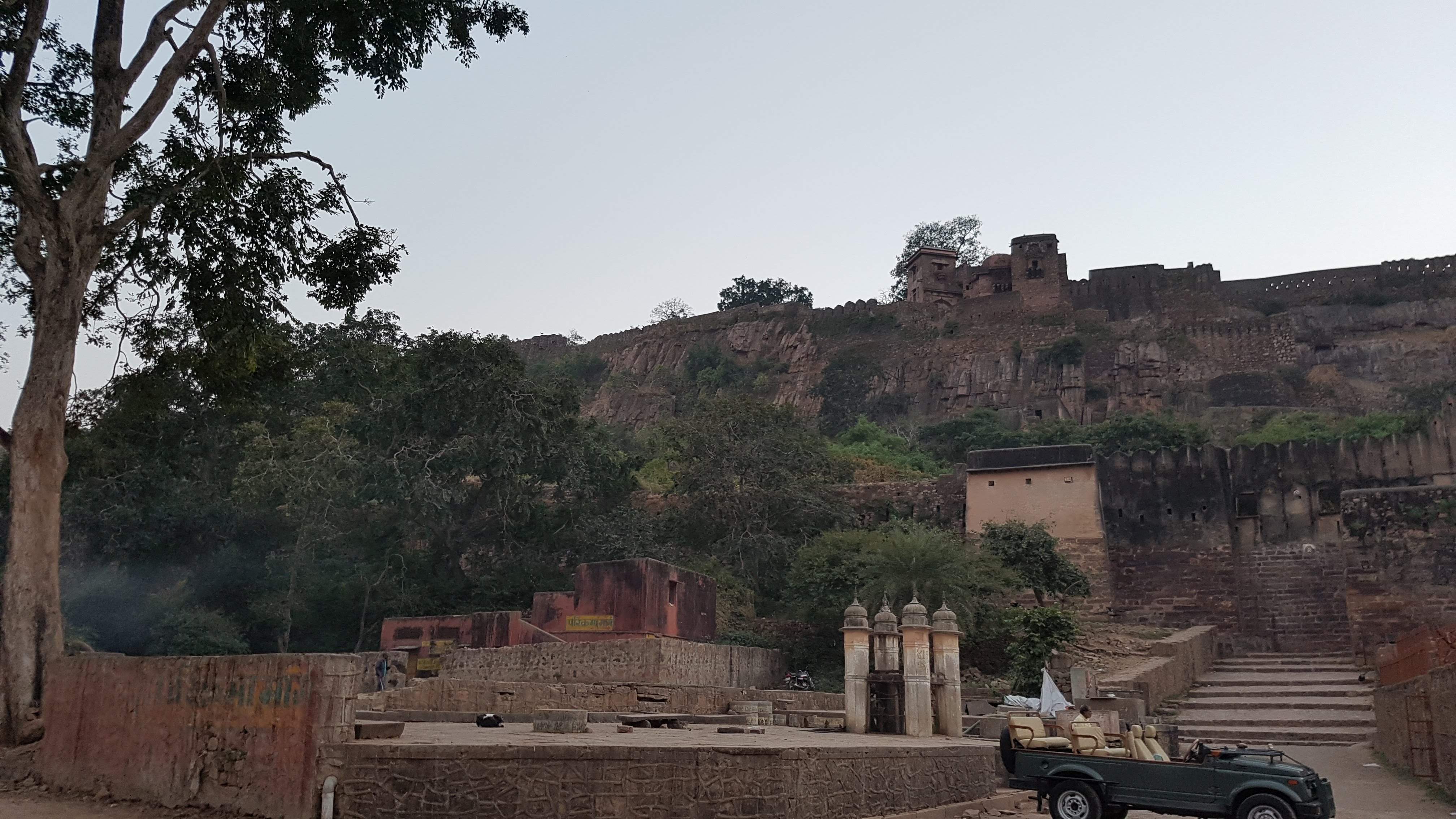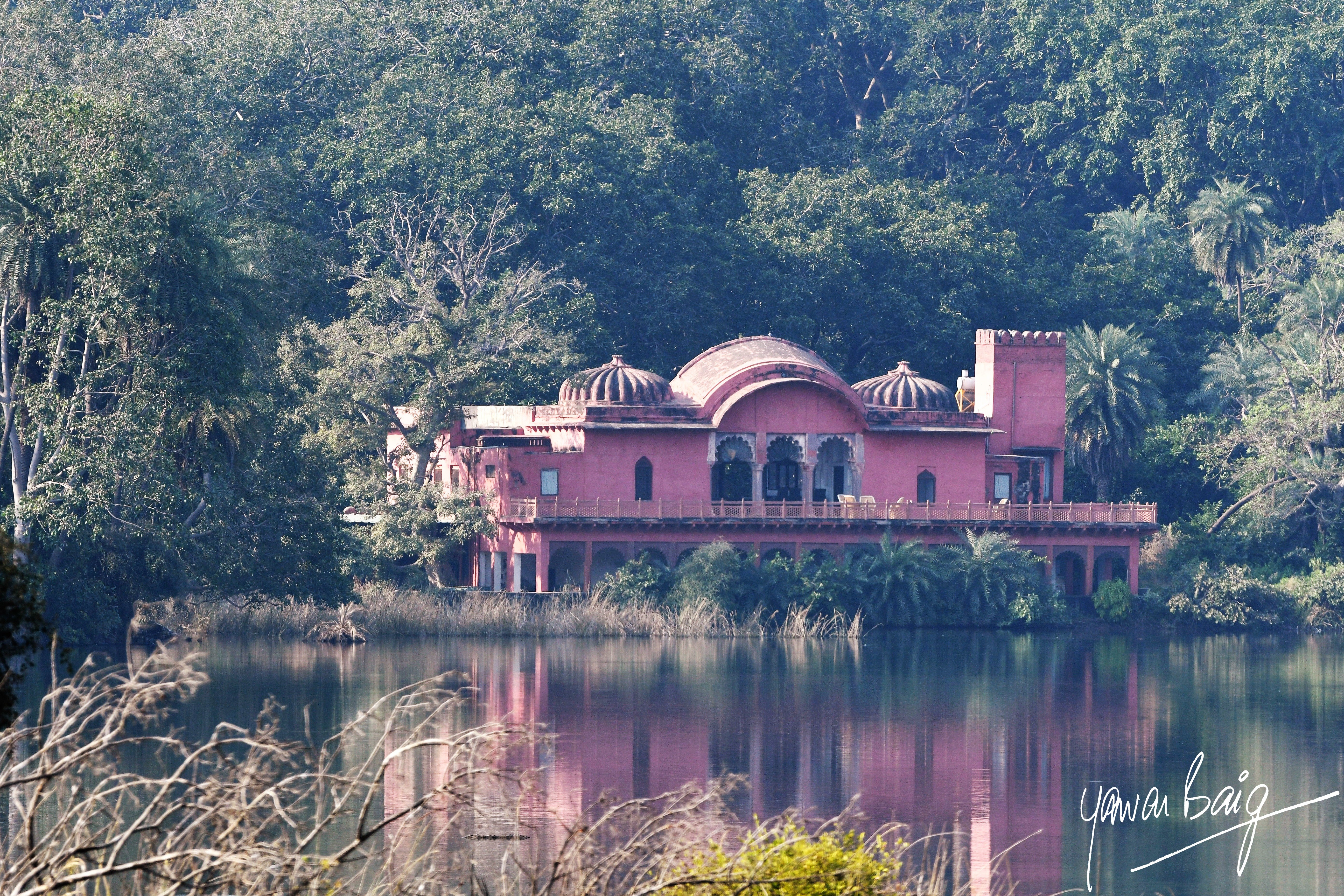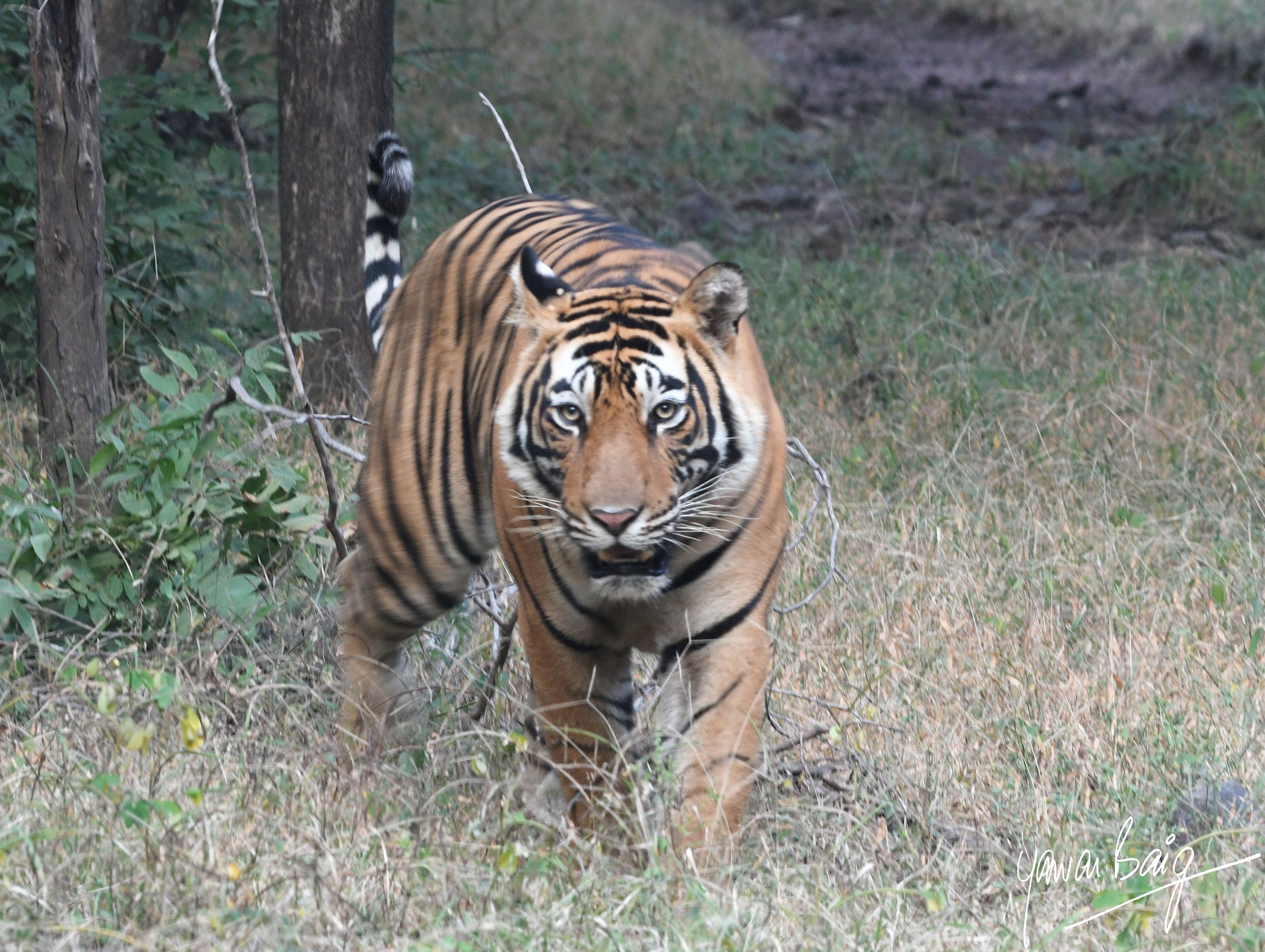Over the past more than ten years I have wandered around almost every tiger sanctuary in India from Kaziranga and Manas in Assam to Idukki in Kerala. I lived in the middle of the Anamallais for seven years. In my childhood and youth in the 1960’s and 70’s, I spent every summer and winter holiday with my dear friend and mentor Uncle Rama (Venkatrama Reddy) in his house on the bank of the Kadam River in the middle of what is today called, Kaval Tiger Reserve. I would spend every single day and many nights in the forest, walking or in a bullock cart. No tiger. I spent ten days in Badhavgarh living in the house of a good friend, alone, in Tala village which is in the buffer zone. I went on safari drives every morning and evening. No tiger. I spent days in Pench, even slept in a dry nala on the boundary of the forest, one hot afternoon. No tiger. I have spent days being jolted around in Gypsy vehicles in sanctuary after sanctuary, my backbone witness to the wear and tear on the suspension of the vehicle and still live to tell the tale. Yet all I saw of the elusive tiger was one glimpse as it leapt across a road in Corbett and a decent sighting in Tadoba. At the end of all this wandering, I concluded that I was jinxed as far as tigers are concerned. But since I love the forest and all those who live in it, I continued to escape to the nearest forest that I could find at every opportunity; tiger or no tiger.
Then I went to Ranthambore. My very first visit. My most gracious host, Sonu Khan and his driver Sajid, ‘promised’ me that I would see a tiger. Having heard such promises from many others over the years, I hardly paid attention to it. I wanted to be in a forest and Ranthambore was not only a forest but one of the most beautiful ones that I have ever been in. Massive banyan trees, flowing streams, lakes, high rocky hills, mysterious pavilions, Muslim graves and even an abandoned masjid near one of the streams. The main river that flows through the forest especially the part that comes down from the Ranthambore fort has ‘inexplicable’ date palms all along it. Inexplicable because though Rajasthan has date palms, this is a different variety, not indigenous to Rajasthan. Excellent perches for kingfishers, owls, parrots and parakeets, as I discovered.
 Ranthambore fort is very impressive to say the least. We were sitting in our Gypsy waiting for the driver to submit the entry pass at the gate house and I looked up at the battlements of the fort in awe at the amazing architectural challenge they would have posed to build. With my interest in military history, my first thought when I saw the battlements rising high into the heavens was, if I were to besiege this fort, how would I do it? I concluded that this fort is impregnable and can’t be conquered keeping in mind the armies and armaments of the time i.e. the 16th century.
Ranthambore fort is very impressive to say the least. We were sitting in our Gypsy waiting for the driver to submit the entry pass at the gate house and I looked up at the battlements of the fort in awe at the amazing architectural challenge they would have posed to build. With my interest in military history, my first thought when I saw the battlements rising high into the heavens was, if I were to besiege this fort, how would I do it? I concluded that this fort is impregnable and can’t be conquered keeping in mind the armies and armaments of the time i.e. the 16th century.
 Later, my dear friend who shares my interest in history and wildlife, Jehangir Ghadiali solved the mystery of the date palms for me. He told me that apparently Ranthambore was besieged for a month by the Moghul Emperor Akbar and then submitted to the Mughals in 1568. Moghul soldiers ate dates and the seeds they discarded sprouted all along the streams that they would have camped on. ‘Mughal soldiers’, is a general term referring the army they fought in. As it was, most of Akbar’s army consisted of Rajputs. It is easy to condemn them as being anti-national but one must realize that the concept of India as one nation is only from 1947. For all our history, we were individual countries that existed in the landmass of the subcontinent, much like European countries exist to this day in the landmass called Europe. Rajput kings fought other Rajput kings and were being patriotic to their tribe and country and not anti-national. The Moghuls capitalized on this and with their superior technology and generalship, they commanded Rajput armies that won the day. Rajputs rose to become generals in Moghul armies and fought loyally for the Moghul Emperor who they considered their liege lord. One of the most famous of Akbar’s generals was Raja Mansingh who was one of this Navratans (9 Jewels – Nobles held in the highest esteem). Today all this sounds strange and that is why history has many lessons to teach us.
Later, my dear friend who shares my interest in history and wildlife, Jehangir Ghadiali solved the mystery of the date palms for me. He told me that apparently Ranthambore was besieged for a month by the Moghul Emperor Akbar and then submitted to the Mughals in 1568. Moghul soldiers ate dates and the seeds they discarded sprouted all along the streams that they would have camped on. ‘Mughal soldiers’, is a general term referring the army they fought in. As it was, most of Akbar’s army consisted of Rajputs. It is easy to condemn them as being anti-national but one must realize that the concept of India as one nation is only from 1947. For all our history, we were individual countries that existed in the landmass of the subcontinent, much like European countries exist to this day in the landmass called Europe. Rajput kings fought other Rajput kings and were being patriotic to their tribe and country and not anti-national. The Moghuls capitalized on this and with their superior technology and generalship, they commanded Rajput armies that won the day. Rajputs rose to become generals in Moghul armies and fought loyally for the Moghul Emperor who they considered their liege lord. One of the most famous of Akbar’s generals was Raja Mansingh who was one of this Navratans (9 Jewels – Nobles held in the highest esteem). Today all this sounds strange and that is why history has many lessons to teach us.
Rai Surjan Hada was apparently demoralized by Akbar’s victories in Chittorgarh and Thanesar and when the Moghul cannons were brought to bear and bombardment started, he decided to capitulate. It was cannons that gave Mughals the edge over their opponents. Babur had cannons when he fought Ibrahim Lodhi thanks to which war elephants which were the ultimate weapon of Indian armies were rendered a liability. War elephants would run amok with terror at the sound of cannon and turn and charge through their own troops, creating havoc. Another thing that gave the Mughal armies the edge was light cavalry using the famous double curved Mongol bow. That gave them mobility and range which effectively nullified the advantage of massive infantry which was the hallmark of Indian armies. European armies of the time had infantry in thousands, but Indian kings could field hundreds of thousands. All this force came to naught when faced with highly mobile cavalry shooting from powerful bows and cannons which though not too accurate at long range, could create total mayhem in massed troops, especially when loaded with scatter shot.
Indian wisdom decided that losing lives unnecessarily would serve no purpose and so Rai Surjan Hada opened the gates to the Moghuls. In my view, Ranthambore fort can withstand a far longer siege and even Akbar would have been hard pressed to keep the siege going for a long period given the issues of supply lines and the semi-arid country that Ranthambore is in. Though the area has forest, which in those days it would have been more, but there is not much in it for an army to eat. That they were eating dates is a sign because dates are dry rations. They would have hunted in the forest but to feed an army needs a lot of meat and animals move away when they are hunted. Not easy, laying siege. This also explains the masjid and pavilions in the middle of the forest.
It is with these thoughts that we entered the forest. We drove through semi-deciduous forest with a variety of bird life. We entered the forest through a beautiful gateway that is today framed by the aerial roots of a banyan tree. In the days of Ranthambore’s glory it would have had soldiers posted on top of it and the gate itself shut, except to those who were authorized to enter. We drove through it and along the track that borders Padam Talao on one end of which is the beautiful Jogi Mahal. That makes Jogi Mahal a part of the Ranthambore fort complex because to get to it you must pass through gates on either end. Imagine that you are a guest of Rai Surjan Hada of Ranthambore in happier times before Akbar came on the scene and are sitting on the deck of Jogi Mahal watching the sunset (I hope I have my directions correct), drinking sherbet and eating savory snacks followed by Rajasthani sweets. The survival of Jogi Mahal through the siege of Ranthambore is evidence that beauty is protection in itself.

There were several waders and other birds in the shallows of Padam Talao. A pair of Indian Thick-knees, simply standing in one place. The Stone Curlew or Thick-knee is active in the dark and feeds at dawn or dusk. During the day it stands still in shade. In this case they were standing at the edge of the lake, in the hope perhaps of getting the odd worm. They had for company a pair of Black-winged Stilts, a most attractive wader whose delicate long legs give it their name; a pair of Brahminy ducks (Ruddy Shelduck) and a solitary Darter drying its wings. A more peaceful scene can’t be imagined.

As I contemplated all this, it occurred to me that all is right with the world. Until I woke up and reminded myself that the reality is far from this. We are at a stage where we humans have wiped out 85% of wildlife and are facing the specter of extinction. It is true that my tiger jinx was broken in Ranthambore and in three days I saw twelve tigers. It is true that when I watch Blue Planet or Planet Earth, with Sir David Attenborough commenting on the glory of nature and the profusion of wildlife, I am carried away with the sheer beauty of what I see. But it is good to remember that the reality is far from this. Very far. Yes, I saw twelve tigers in Ranthambore, but tigers are so seriously endangered as to be close to becoming extinct in the wild in India. Our population pressure, total ignorance and apathy towards forests and wildlife, greed to make money at any costs and a political class that is innocent of any ethics, responsibility or knowledge, means that forests and wildlife continue to get short shrift. Every mining concession, highway or railway line tends to get precedence over the forest that it will either seriously endanger or completely destroy. It is no secret that tiger reserves which get a higher level of protection from reserve forests, were systematically de-tigered so that the status of the forest could be officially downgraded to reserve forest, in order to start mining for marble.

The solution is to educate people. Ordinary people like you and me, about the importance of forests and wildlife and how our own survival is intrinsically linked with it. Self-interest may not be the most noble emotion, but I believe that unless people understand the importance of forests and wildlife, they will not do anything to protect it. As it is, people at best consider forests to be a source of entertainment and tigers and other wildlife to be performing artists which must put in an appearance for people to get value for money. Forest Department officials succumb to this pressure and I know of instances where, using tame elephants, tigers are driven to the road from where they are resting in the heat of the day, so that tourists can take photos.
The challenge is to educate those who will be affected by global changes. What is their level of awareness? Simply ask anyone the meaning of “Big Data”, “Artificial Intelligence”, “Peak Oil”, “Climate Change”, “Global Warming” and you have the answer. Most people simply don’t even know what these things are, much less how they will be personally affected by them. The powers that be, the billionaires who rule the world, manufacture weapons of mass destruction and sell them to those willing to use them on their own populations, while stridently calling for peace; benefit from wars, forest depletion, polluting industries, global poverty and oppression. Looking to them to bring about change is like asking the tiger to eat grass. That is the challenge.
How do we show the oligarchs that eliminating poverty is not for the benefit of the poor but so that a bigger market can be created for what the oligarchs sell? How do you convince those who work in weapons factories that living off the blood of others is immoral? Educating the public seems to be the obvious answer but the challenge is to find a way to do it fast enough to energize people to stand up and make a difference.